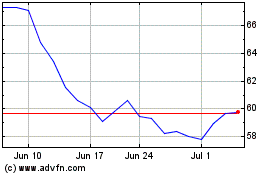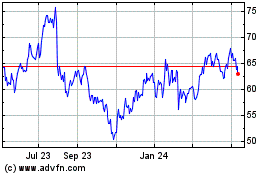PayPal Doubles Down as Coronavirus Shifts Payments -- Heard on the Street
July 30 2020 - 6:29AM
Dow Jones News
By Telis Demos
PayPal Holdings users have been buying online like it's Cyber
Monday every day.
The digital-payment company grew rapidly in the first quarter
despite a big decline in important spending categories like travel
and events. The continuing shift from cash and in-store card
spending to digital and e-commerce shopping is more than making up
for continuing weakness in that kind of spending.
Total payment volume grew 30% from a year earlier in the second
quarter in constant currency terms, despite a nearly two-thirds
drop in travel and events. That is up from 19% growth in the first
quarter. June was the fastest-growing volume month for PayPal since
it separated from eBay in 2015. Notably, even cross-border
transactions grew 24% in the second quarter from a year earlier:
People may not be traveling, but online shoppers are happy to
digitally cross borders.
Even if some old habits return, PayPal has now sharply expanded
its core user base. It added more net new active users in the
quarter than it did in all of 2016. It also added 1.7 million more
merchants who accept PayPal in some form, about triple the usual
quarter's growth.
The question for investors is, when the world returns to
something resembling normal, will PayPal have permanently altered
its place in the landscape? That depends in part on some
initiatives now under way. PayPal said it has struck a deal with
CVS Pharmacy to enable the retailer to add PayPal and Venmo QR
codes to store checkouts, allowing users to easily pay with their
smartphones. If PayPal can take a meaningful share of in-store
shopping, where it hasn't had a big presence historically, that
could bolster its position among rivals.
PayPal is also trying to make itself stickier with consumers by
adding more services to its wallet. For example, it now enables
Venmo users to directly deposit their paychecks into their digital
coffers. It is in the process of rolling out bill payments and new
ways to manage rewards points.
One headwind is that one of PayPal's most historically lucrative
added services, lending, is a drag right now. Other value-added
services revenue, which includes lending, shrank 26% from a year
ago, hit by fewer merchant loan originations, lower interest rates,
customer forbearance actions and larger loan-loss provisions.
Some of those effects will likely prove temporary, but investors
buying into a stock that has already risen 70% this year will need
to watch PayPal's broader initiatives closely. PayPal's core
operating margin expanded by more than 5 percentage points in the
quarter from a year earlier. The company said it would invest that
in new growth. That takes the added income away from shareholders
for now, but doubling down and giving retailers and consumers
reasons to permanently change the way they pay and do business is
the right move. As Chief Financial Officer John Rainey put it: "We
want to help shape the outcome here."
For one thing, putting more marketing spend behind PayPal's QR
codes, which aren't as familiar a mechanism to many U.S. shoppers
as they are elsewhere in the world, will be vital -- especially
since other mobile wallets, like Apple Pay, are likewise charging
ahead into this transition. This is no time for PayPal to sit back
and count its winnings.
(END) Dow Jones Newswires
July 30, 2020 06:14 ET (10:14 GMT)
Copyright (c) 2020 Dow Jones & Company, Inc.
PayPal (NASDAQ:PYPL)
Historical Stock Chart
From Mar 2024 to Apr 2024

PayPal (NASDAQ:PYPL)
Historical Stock Chart
From Apr 2023 to Apr 2024
